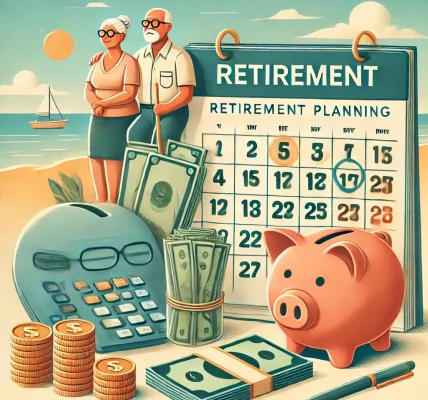Retirement planning is a crucial step in ensuring financial security in your later years. Choosing the right retirement plan based on your income level can significantly impact your long-term financial stability. With multiple options available, it’s essential to understand which plans provide the best returns and align with your financial goals.
Why Income Level Matters in Retirement Planning
Your income level plays a vital role in determining how much you can contribute toward your retirement fund. It also influences the type of plans you qualify for, the tax benefits you can leverage, and the level of risk you can afford to take. Here’s how different income groups can approach retirement planning:
1. Low-Income Earners ($20,000 – $50,000 per year)
For low-income earners, affordability and security are key factors when choosing a retirement plan. Here are some options:
a. Government-Backed Pension Plans
Many countries offer government-backed retirement schemes designed to help low-income individuals. Examples include:
- Social Security Benefits (U.S.)
- Employee Provident Fund (EPF) (India)
- National Pension Scheme (NPS) (India)
- Public Pension Plans (UK, Canada, Australia, etc.)
These plans provide a guaranteed income after retirement, making them an excellent choice for those with limited financial flexibility.
b. Employer-Sponsored Retirement Plans
Many employers offer retirement plans, such as 401(k) (U.S.) or Superannuation Funds (Australia), where they match employee contributions up to a certain limit. This is essentially free money that boosts your retirement savings.
c. Individual Retirement Accounts (IRA) & Roth IRA
In the U.S., a traditional IRA allows tax-deferred growth, while a Roth IRA offers tax-free withdrawals in retirement. Low-income earners may qualify for the Saver’s Credit, providing additional tax advantages.
2. Middle-Income Earners ($50,000 – $150,000 per year)
Middle-income earners have more options to optimize their retirement savings while balancing current financial needs.
a. Employer-Sponsored Plans with Higher Contributions
Maximizing contributions to a 401(k), 403(b), or similar retirement plan is a great way to build a substantial retirement fund. Employers often match contributions up to a certain percentage, amplifying savings.
b. Investment-Based Retirement Plans
- Index Funds & ETFs: These offer low-cost, diversified investments with steady returns over time.
- Mutual Funds: Actively managed funds that can potentially yield higher returns, though they come with some risk.
- Fixed Deposits & Bonds: Safe investment options that provide stable returns.
c. Tax-Advantaged Accounts
- Health Savings Accounts (HSA): Can be used for medical expenses tax-free in retirement.
- Traditional IRA/Roth IRA: Continue contributing based on tax advantages suited to your income bracket.
3. High-Income Earners ($150,000+ per year)
High-income individuals have more flexibility to diversify their retirement plans and invest in higher-return options.
a. Maximizing Tax-Deferred Contributions
- Contribute the maximum limit to 401(k) plans, SEP IRAs, and Defined Benefit Plans.
- Utilize Backdoor Roth IRA conversions to bypass income limits on Roth IRA contributions.
b. Alternative Investment Strategies
- Real Estate Investment: Rental income can provide long-term financial security.
- Stocks & Private Equity: Higher returns with increased risk.
- International Investment Funds: Diversification across global markets can reduce risks.
c. Deferred Compensation Plans
These plans allow high-income earners to defer part of their salary until retirement, reducing current tax liability and providing financial security later.
Comparing Returns: Which Plan Works Best?
| Plan Type | Estimated Annual Return | Risk Level | Best For |
|---|---|---|---|
| 401(k) (With Employer Match) | 5-8% | Medium | All Income Levels |
| Roth IRA | 6-10% | Medium | Middle & High-Income Earners |
| Index Funds | 7-10% | Medium | Middle & High-Income Earners |
| Real Estate Investment | 8-12% | High | High-Income Earners |
| Bonds & Fixed Deposits | 3-5% | Low | Low & Middle-Income Earners |
| Government Pension Plans | 3-6% | Low | Low-Income Earners |
Tips for Maximizing Your Retirement Returns
- Start Early: The power of compounding significantly increases returns over time.
- Diversify Your Portfolio: Invest in a mix of stocks, bonds, and alternative assets.
- Maximize Employer Contributions: Take full advantage of matching benefits.
- Monitor & Adjust Your Plan: Periodically review investments and adjust allocations as needed.
- Consider Tax Benefits: Utilize tax-advantaged accounts to reduce taxable income and increase savings.
Final Thoughts
Choosing the best retirement plan based on your income level requires careful planning, smart investment strategies, and consideration of tax benefits. While government-backed pension plans and employer-sponsored programs provide a strong foundation, additional investments in stocks, bonds, or real estate can help maximize returns.
By aligning your retirement strategy with your income level and long-term goals, you can build a financially secure future and enjoy a comfortable retirement. Start planning today and take control of your financial destiny!




